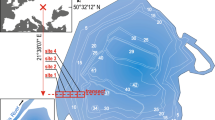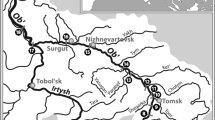Abstract
The macrobenthos in the oligohaline 132 km reach of the Lower St. Johns River, Florida, is an unusual blend of freshwater and marine organisms within the annelid, mollusk, aquatic insect, and crustacean groups. During 1993–1994, the community composition was freshwater-oriented in the 47 km (seg I) and estuarine-dominated in the lower 85 km (seg II). Of the total 146 taxa collected, 89% were euryecious 'eutrophic' and 'pollution-tolerant' organisms. Densities ranged between 5000 and 20 000 individuals/m2 ann av and maximum densities (85 000 individuals/m2) occurred in the muck substrate at the confluence of major tributaries and embayments. Throughout the lake-like seg II, benthic hypoxia existed during much of summer through fall. Biotic index values for grab, artificial substrate, and sled trawl samples reflected greatest stresses to the macrobenthos then. Both low taxonomic diversity and densities of organisms at the most downriver stations nearest the port of Jacksonville indicated that toxic substances also adversely affected the macrobenthos. Maintenance of the narrow band of littoral submerged aquatic vegetation (SAV) and adjacent shoreline riparian vegetation is important to sustain macrobenthic communities and other kinds of aquatic life in the river.
Similar content being viewed by others
References
American Public Health Association (APHA), et al.: 1989, ‘Standard Methods for the Examination of Water and Wastewater’, 17th ed., Washington, DC.
Association of State and Interstate Water Pollution Control Administrators (ASIWPCA): 1982, ‘America's Clean Waters - The State's Evaluation of Progress 1972–1982 (Appendix)’, Washington, DC.
Bass, D. G., Jr.: 1990, ‘Riverine Fishes of Florida’, in: R. J. Livingston (ed.): The Rivers of Florida, Springer-Verlag, New York, pp. 65–83.
Benke, A. C., Van Arsdall, T. C., Jr., Gillespie, D. M. and Parrish, F. K.: 1984, ‘Invertebrate productivity in a subtropical blackwater river: the importance of habitat and life history’, Ecological Monographs 54(1), 25–63.
Bergman, M: 1992, Lower St. Johns River Basin reconnaissance: Vol. 2. Tech. Publ. SJ 92–1. St. Johns River Water Management District, Palatka, Florida. 134 pp.
Berner, L. and Pescador, M. L.: 1988 (revised), The Mayflies of Florida, University Presses of Florida, Gainesville and Tallahassee. 415 pp.
Brody, R.W.: 1994, ‘Lower St. Johns River Basin reconnaissance: biological resources'. Tech. Publ. SJ94–2, Vol. 6. St. Johns River Water Management District, Palatka, Florida. 108 pp.
Brower, J. E. and Zar, J. H.: 1984, Field and Laboratory Methods for General Ecology, Wm. C. Brown Publishers, Dubuque, Iowa.
Burgess, G. H. and Franz, R.: 1978, ‘Zoogeography of the aquatic fauna of the St. Johns River system with comments on adjacent peninsular faunas’, American Midland Naturalist 100(1), 160–170.
Campbell, D., Bergman, M., Brody, R., Keller, A., Livingston-Way, P., Morris, F. and Watkins, B.: 1993, SWIM plan for the Lower St. Johns River. St. Johns River Water Management District, Palatka, Florida, 175 pp.
Chutter, F.M.: 1972, ‘An Empirical Biotic Index of the quality of water in South African streams and rivers’, Water Research 6, 19–30.
Cox, D. T., Vosatka, E. D., Horel, G., Eisenhauer, R., Moody, H. L., Connor, L. L. and Smith, R.: 1981. ‘Study I. St. Johns River Fishery Resources, Ecological aspects of the fishery’, Completion Report for investigations project (1976–1981). D-J Proj. F-33. Florida Game and Fresh Water Fish Commission, Tallahassee, Florida (USA).
Elliott, J.M.: 1977, ‘Some Methods for the Statistical Analysis of Samples of Benthic Invertebrates’, Freshwater Biological Association, Scientific Publ. 25, The Ambleside, Westmoreland, England, 160 pp.
Florida Department of Natural Resources (FLDNR): 1989, ‘Florida rivers assessment’, Division of Recreation and Parks, Tallahassee. 452 pp.
Gilbert, C. R. (ed.): 1978, ‘Fishes’, Part 4, in: Rare and Endangered Biota of Florida, University of Florida Presses, Gainesville. 58 pp.
Hackney, C. T., Adams, S. M. and Martin, W. H.: 1992, Biodiversity of the Southeastern United States: Aquatic Communities, John Wiley, New York, 794 pp.
Hilsenhoff, W. L.: 1988, ‘Rapid field assessment of organic pollution with a family level biotic index’, J. North Am. Benthological Soc. 7(1), 65–68.
Intergovernmental Task Force on Monitoring Water Quality (ITFM): 1994, ‘Water quality monitoring in the United States’, U.S. Geologic Survey, Office of Water Data Coordination, Reston, Virginia. 29 pp.+Tech. Appendices.
Ketchum, B. H.: 1982, ‘Nutrients in the marine environment’, pp. 68–85 in T. W. Duke: Impact of Man on the Coastal Environment. EPA-600/ 8–82–021, Office of Research and Development, USEPA, Washington, DC, 114 pp.
Klemm, D. J., Lewis, P. A., Fulk, F. and Lazorchak, J. M.: 1990, ‘Macroinvertebrate Field and Laboratory Methods for Evaluation, the Biological Integrity of Surface Waters’, EPA-600/490/030, Office of Research and Development, USEPA, Washington, DC, 256 pp.
Livingston, R. J.: 1976, ‘Diurnal and seasonal fluctuations of organisms in a North Florida estuary’, Estuarine and Coastal Marine Science 4, 373–400.
Lewis, F. G., III: 1984, ‘Distribution of macrobenthic crustaceans associated with Thalassia, Halodule, and bare sand substrata’, Marine Ecology 19, 101–113.
Llanso, R. J.: 1992, ‘Effects of hypoxia on estuarine benthos: the Lower Rappahannock River (Chesapeake Bay), a case study’, Estuarine, Coastal and Shelf Science 35, 491–515.
Mackenthun, K. M., Ingram, W. M. and Porges, R.: 1964, ‘Limnological Aspects of Recreational Lakes’, U.S. Public Health Service, Publ. 1167, R.A. Taft Sanitary Engineering Center, Cincinnati, OH, 176 pp.
Mason, W. T., Jr.: 1991a, ‘A survey of benthic invertebrates in the Suwannee River, Florida’, Environmental Monitoring and Assessment 16, 163–187.
Mason, W. T., Jr.: 1991b, ‘Sieve sample splitter for benthic invertebrates'. J. Freshwater Ecology 6(4), 445–449.
Mason, W. T., Jr. and Zengel, S. A.: ‘Foods of juvenile spotted seatrout in seagrasses at Cedar Keys, Florida’, Gulf of Mexico Science, (in press).
Mason, W. T., Jr., Lewis, P. A. and Hudson, P. L.: 1975, ‘The influence of sieve mesh size selectivity on benthic invertebrate indices of eutrophication’, Verh. Internat. Verein. Limnol. 19, 1550–1561.
Mason, W. T., Jr., Lewis, P. A. and Weber, C. I.: 1985, ‘An evaluation of benthic macroinvertebrate biomass methodology’, Environmental Monitoring and Assessment 5, 399–422.
Mason, W. T., Jr., Mattson, R. A. and Epler, J. H.: 1994, ‘Benthic invertebrates and allied macrofauna in the Suwannee River and Estuary ecosystem, Florida’, Florida Scientist 57(4), 141–160.
Novotny, V., Braden, J., White, D., Jones, H. and Schonter, R.: 1994, ‘Identification and Evaluation of Use Attainability Methodology for Aquatic Ecosystems’, Water Environment Research Foundation, Alexandria, Virginia.
Plafkin, J. L., Barbour, M. T., Porter, K. D., Gross, J. R. and Hughes, R. M.: 1989, ‘Rapid Bioassess ment Protocols for Use in Streams and Rivers: Benthic Macroinvertebrates and Fish’, Publ. EPA/440/4–89–001, Office of Water, U.S. Environmental Protection Agency, Washington, DC.
Pullen, E. J., Mock, C. R. and Ringo, R. D.: 1968, ‘A net for sampling the intertidal zone of an estuary’, Limnology and Oceanography 13, 200–202.
Reid, G. K.: 1961, Ecology of Inland Waters and Estuaries, Reinhold Book Corp., New York, 375 pp.
Sawyer, C. N.: 1947, ‘Fertilization of lakes by agricultural and urban drainages’, J. New England Water Works Assoc. 61, 109.
Swartz, R. C., Deben, W. A., Sercu, K. A. and Lamberson, J. O.: 1982, ‘Sediment toxicity and the distribution of amphipods in Commencement Bay, Washington, USA’, Marine Pollution Bulletin 13(10), 359–364.
Tagatz, M. E.: 1967, ‘Fishes of the St. Johns River, Florida'. Quart. J. Florida Acad. Sci. 30, 25–50.
U.S. Environmental Protection Agency (USEPA): 1975, ‘National Water Quality Inventory 1975 Report to Congress’, Office of Water Planning and Standards, Washington, D.C. 48 pp.+ Appendices.
U.S. Environmental Protection Agency (USEPA): 1976, ‘Quality criteria for water’, Office of Water and Hazardous Materials, Washington, DC, 256 pp.
Watkins, B.: 1992, ‘Florida Governor's nomination of the Lower St. Johns River Estuary to the National Estuary Program’, St. Johns River Water Management District, Palatka, Florida, 169 pp.
Rights and permissions
About this article
Cite this article
Mason, W.T. Macrobenthic Monitoring in the Lower St. Johns River, Florida. Environ Monit Assess 50, 101–130 (1998). https://doi.org/10.1023/A:1005802229832
Issue Date:
DOI: https://doi.org/10.1023/A:1005802229832




